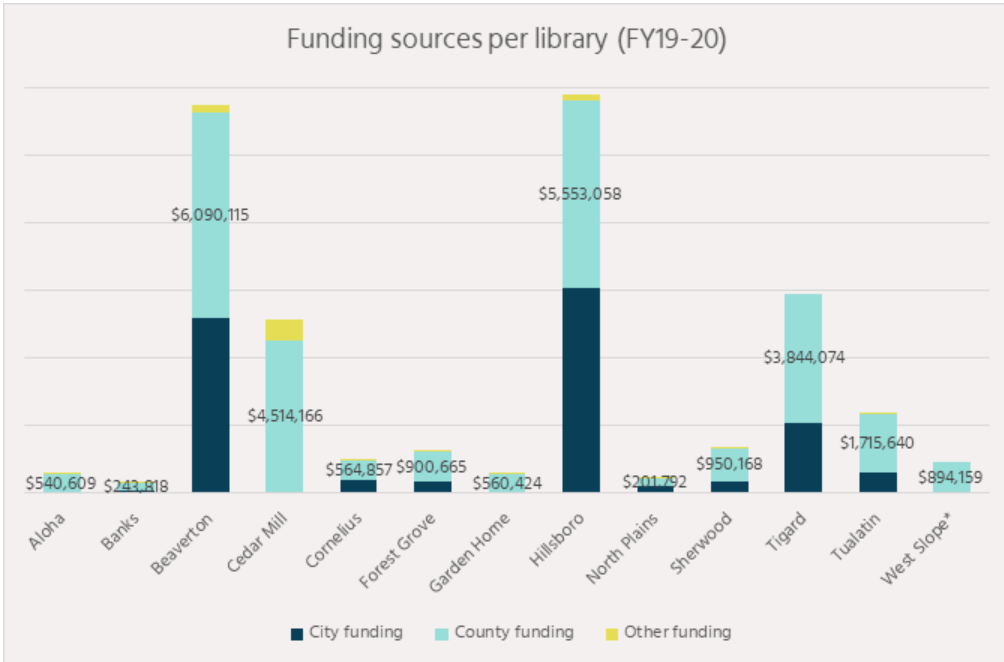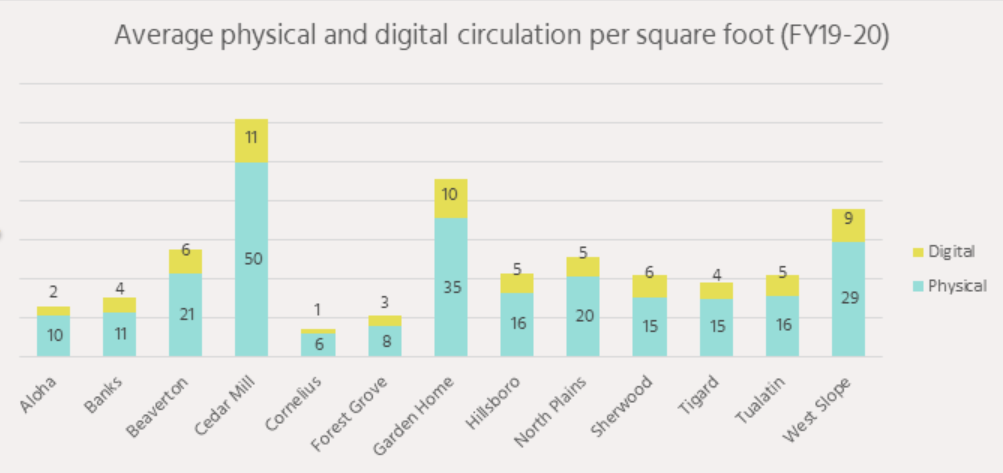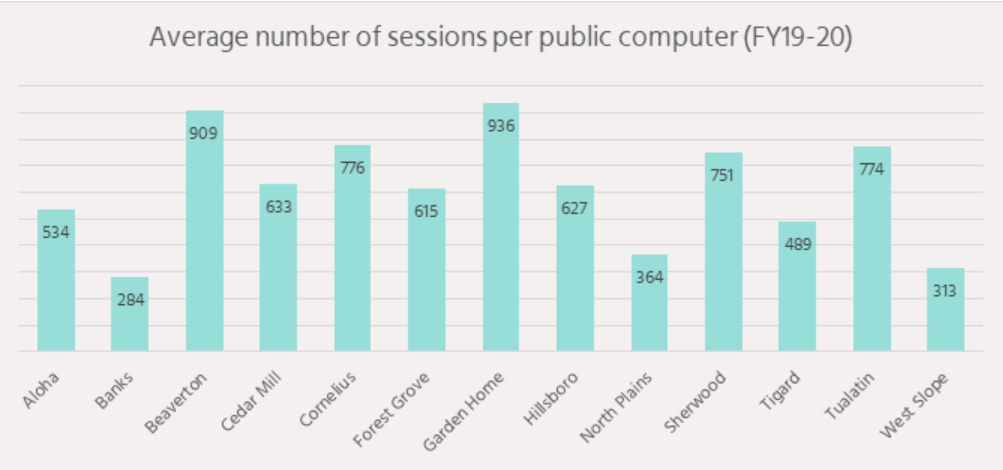Executive summary
Voters approved the renewal of WCCLS’ levy at the existing rate in May 2020. With no increased revenue, WCCLS is not able to increase funding allocations to any library without decreasing allocations to another library. Decreasing funding to some libraries would go against our commitment to voters to maintain open hours at all libraries and avoid cuts in service. We acknowledge that there are equity issues with the current funding distribution model, and also understand the complexities of our structure mean changes need to be made thoughtfully and with community input. We appreciate the support of our Board of County Commissioners for a robust and inclusive process to improve our funding distribution model as we lead up to the next levy cycle, starting in July 2026.
WCCLS commitment to equity and diversity
Washington County Cooperative Library Services’ (WCCLS’) funding model for our member libraries will be changing with our next levy cycle, beginning in July 2026. Our legacy approach to funding did not adequately address equity concerns that are central to the county’s commitment to ensure that libraries are accessible for all Washington County residents, nor did it address whether service funding is aligned with community needs. In the past, the cooperative used circulation (the number of items checked out of the library) as a primary metric to allocate funding to libraries. This likely favored wealthier communities with local funds that allowed them to build new buildings and develop large collections to draw users. This created disparities in funding for library services across the county. The underlying foundations of this system haven’t been fundamentally evaluated. However, there have been beneficial corrections over the years, most recently in 2016 when voters approved a five-cent increase in our levy rate.
We acknowledge these historical shortcomings and will be creating a process to involve community input and data analysis to implement a new funding model. Our community engagement process will center around the needs of residents who have been traditionally underserved, including people of color, our houseless neighbors, the elderly and disabled, and those without ready access to the internet or who lack transportation. With the support of our Board of County Commissioners, we are allocating funding for the next four fiscal years to support the design and implementation of this process.
Background on complex governance and funding of Washington County libraries
The issue of how each library is funded is complex, because each library is independent and unique in how it is governed: nine are operated by cities, three are operated by non-profits, and one – West Slope – is owned and operated by the county. Non-profit libraries and the West Slope Library are heavily funded by the county because they are in unincorporated areas of the county and have no other governmental revenue stream.
City libraries have the benefit of receiving funding from both the county and their individual cities. There is variance in the amount of support cities dedicate to their library systems, and there is no minimum required contribution of local support from cooperative members. The graph below shows the proportion of each library’s revenue that is provided by the county, versus the amount of support each city allocates to its library. West Slope (as the only county-run library) is the only library that should expect to rely on the county as its sole funding source. Funding library initiatives and services in our cooperative is a shared financial responsibility and partnership.


What library metrics show (and what they don’t)
Using “service population” or per capita statistics as a measure of a library’s reach or effectiveness doesn’t give an accurate picture of actual service provided. Libraries that border Multnomah and Clackamas counties serve large numbers of out-of-county residents (per a long-standing agreement with other library systems in the metro region) but only Washington County residents are counted as the official service population.
A different metric for comparing libraries is by square footage. The graph below shows activity in Washington County libraries by their square footage and open hours. Counting the number of visits patrons make to a library building, and then adjusting that per the library’s open hours and square footage, is just one way to gauge activity. Libraries serve many needs, and each community uses its library in different ways.
For example, take two libraries in a similar geographic area. The table below shows that Garden Home is one of the busiest libraries in our cooperative when evaluated by average visits per open hour, per square foot. Does that mean its large neighbor, Beaverton, is not well-used? Not at all. User behavior in different types of libraries and communities also should be factored in. Garden Home is small and sees many quick visits from patrons picking up items on hold. Beaverton is a larger building with more amenities and services that would draw users to stay for a longer time. This illustrates the complexities of analyzing such a unique cooperative system with so many variables. Reliance on any single metric will result in a flawed analysis.



Funding realities: How we’re preserving existing services
We are grateful for the support voters showed WCCLS when they approved a renewal of the existing levy rate in May 2020. Since the levy rate is a renewal, WCCLS will not have any additional funding to distribute to libraries unless the Board of Commissioners approves an increase in the levy rate, and unless voters approve that increase for the next levy cycle, which begins in July 2026. With the current revenue available, allocating additional money to one library would mean an equal amount would need to be taken away from another. This would trigger operational cutbacks, which would not be in keeping with the commitment we made to voters in the May 2020 levy vote: “Renewal of the levy helps libraries by… [m]aintaining open hours at all libraries, avoiding cuts in service.”
In order to allow libraries funding for their current level of service, WCCLS will be spending down some of our reserve balance throughout the term of the current levy cycle, ensuring we do not dip below three months of operating expenditures. This is what we can responsibly spend on direct library service and still ensure we have enough cash reserve to continue operations for three months in the event of an emergency.
We also will be holding our digital book expenditures (the popularity of digital books has had tremendous growth in the last two years) to a 5% increase each year, in order to provide a 3% annual increase in funding to member libraries through June 2026.
This plan was supported by the Washington County Board of Commissioners at its work session on Sept. 14, 2021.
Action plan for equitable funding
WCCLS will budget funds each year for the next four years in order to re-evaluate our cooperative’s funding structure in a data-informed way that engages our communities and enables us to achieve our equity and inclusion goals effectively, efficiently and comprehensively. This blueprint will be completed before the end of the current levy cycle.
WCCLS appreciates the support of our Board of County Commissioners for maintaining stable countywide library service, and their support for a process to evaluate and improve our complex funding structure, starting next fiscal year.
